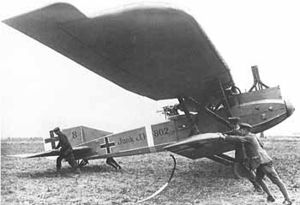Junkers J.I
| Junkers J.I | |
|---|---|

| |
| Role | Ground Attack |
| Manufacturer | Junkers |
| Designer | Hugo Junkers |
| First flight | 27 Jan 1917[1] |
| Introduction | 1 Aug 1917[2] |
| Primary user | |
| Number built | 227 |
| Wingspan | 16.0 m (52 ft 5 in) [3] |
| Engine | 200hp Benz Bz.IV inline |
| Armament | 1 flexible rear Parabellum LMG 14 |
| Ammo | 4 drums of 200-250 rounds[4] |
| Crew | 2 |
| Max Speed | 155 km/h (96 mph)[5][6][7][3] |
| Climb | 1,000 m (3,280 ft) in 12:30[7] 2,000 m (6,560 ft) in 32:00[5][3] or 33:48[7] 3,000 m (9,840 ft) in 77:00[7] |
| Range | 310 km (190 mi)[6][3] |
| Endurance | ~2:00 [5] |
Two-hundred twenty-seven Junkers J.I ground-attack aeroplanes were completed in 1917-1918. The armored "bathtub" protecting the crew, engine, and fuel, the duralumin skin, and the internal wing bracing made it a superbly robust low-level aircraft. Only the engine bearers were made of wood (in order to reduce vibration). Though experiments were made with downward-firing fixed guns and cannons, the plane was already enough for a 200hp engine to push around and the single Parabellum plus grenades remained standard.
Once the plane reached the front, it was known to come back with dozens of holes through the wings, tail, and rear fuselage that the aircraft easily ignored. On some missions the J.I was accompanied by higher-flying CL-Class planes for protection, but for basic ground contact and enemy identification it frequently flew alone or with another J.I.[8]
The flight controls were all enclosed in the fuselage and consisted of cranks and push rods rather than the conventional cables, adding to the J.I's resistance to small-arms fire.[9]
Since the design was so unusual and the Junkers factory was fairly inexperienced, production levels were never as high as hoped.
For more information, see Wikipedia:Junkers J.I.
Timeline [note 1]

Game Data
Wings of Glory
| Availability | Maneuver | Damage | Dmg Points | Max Alt. | Climb |
|---|---|---|---|---|---|
| 18Q1-18Q4 | Y | -/B | 20 | 9 | 8 |
Plane and Crew Cards
-
FA(A) 217
RAF -
FA(A) 221
Schäfer+Schreiber
RAF -
RAF -
FA(A) 208
Guntruck -
FA(A) 217
Guntruck -
FA(A) 221
Guntruck -
FA(A) 250
Guntruck -
FA(A) 263
Guntruck
Card Links
Blue Max/Canvas Eagles
Miniatures and Models
1:144 Scale
- Shapeways full-color: Reduced Aircraft Factory: 119/17 [FA(A) 217], 134/17 [FA(A) 221], 586/18
- Shapeways paintable: Decapod, Reduced Aircraft Factory
- Metal kit: Reviresco
1:200 Scale
- Shapeways: Reduced Aircraft Factory
1:285/6mm/1:288 Scale
- Shapeways: Reduced Aircraft Factory
- Metal Cast: Goblintooth/H.A./MSD GEG-14
1:350 Scale
- Shapeways: Reduced Aircraft Factory
Resources
Orthographic Drawings
References
- Notes
- Citations
- Bibliography
- Peter Gray and Owen Thetford. German Aircraft of the First World War. Great Britain, Putnam, 1962, 1987. ISBN 0-85177-809-7.
- Peter M. Grosz, "Archiv -- Frontbestand". WW1 Aero, № 107, Dec 1985 and № 108, Feb 1986. Poughkeepsie, NY: World War I Aeroplanes, Inc.
- P.M. Grosz, Windsock Datafile 39: Junkers J.I. Great Britain, Albatros Publications Ltd., 1993. ISBN 0-948414-49-9
- Jack Herris, German Armored Warplanes of WWI. USA: Aeronaut Books, 2012. ISBN 978-1-935881-11-7
- Kevin Kelly, "Belts and Drums: A Survey of First World War Aircraft Ammunition Totals". Over the Front, Vol. 5, No. 3, Autumn 1990. Walsworth Publishing Co, Inc. and The League of World War I Aviation Historians.
- W.M. Lamberton and E.F. Cheesman, Reconnaissance & Bomber Aircraft of the 1914-1918 War. Great Britain: Harleyford Publications Ltd., 1962. ISBN 9780900435027
- Kenneth Munson, Bombers: Patrol and Reconnaissance Aircraft, 1914-1919. New York: The MacMillan Company, 1968, Blandford Press Ltd. ISBN 978-0753721711












